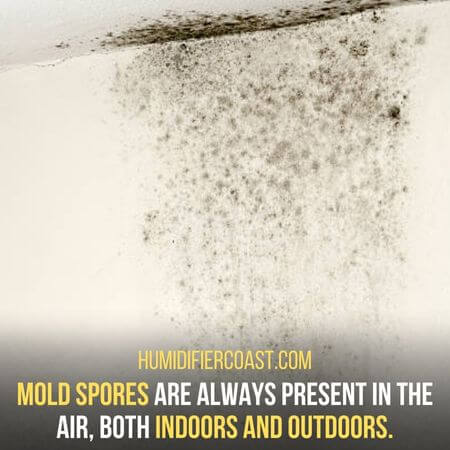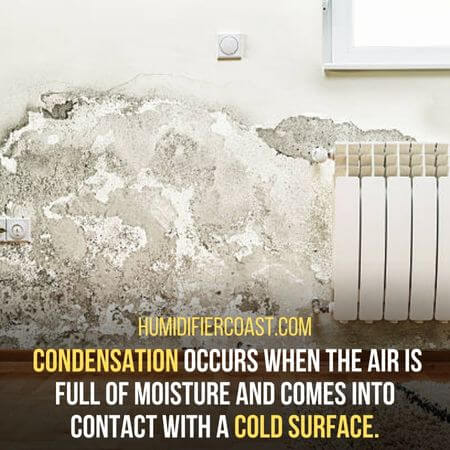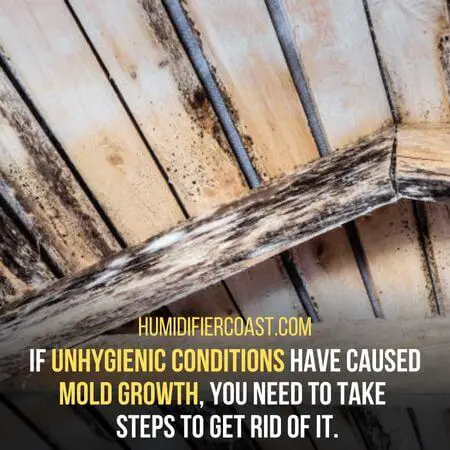Can a humidifier cause mold in a room? Of course, yes, if you do not clean it often or live in a high humidity environment.
Mold spores are always present in the air, both indoors and outdoors.
Can A Humidifier Cause Mold In A Room?
Mold likes to grow in damp, humid, and warm areas. Thus a humidifier can cause mold to grow in a room if the conditions are right.
What are the conditions that can lead to mold growth? Let’s find out.
Ideal Conditions For Mold Growth:
The ideal conditions for mold growth are:
– Temperatures between 77 and 86 degrees Fahrenheit.
– Humidity levels above 60 percent.

– A food source for the mold, such as dust, paper, or wood.
– A dark and poorly ventilated area.
If your room meets these conditions, then there is a chance that mold can grow.
And here is how humidifiers can cause mold growth in a room.
1. Too Much Humidity:
Certain humidifiers can increase the humidity in a room to too high. If the moisture in your room is above 60 percent, it provides the perfect environment for mold to grow.
Not only does mold like these high humidity levels, but it also needs them to reproduce.
The spores of the mold reproduce by releasing tiny particles into the air. These particles are called “conidia.”
Conidia are like seeds that can start new mold colonies. So, if the humidity in your room is too high, the mold spores will release more conidia. Thus, the mold will spread quickly.
2. Poor Ventilation :
Another factor that can lead to mold growth is poor ventilation. If a room is not well ventilated, the air will be stagnant.
Stagnant air does not circulate well, and it can cause the humidity to build up. As we mentioned before, high humidity is one of the ideal conditions for mold growth.
When you have a humidifier in a room, ensure good ventilation. You can open a window or use an exhaust fan to help circulate the air.
However, do so when humidity levels are moderate. If the humidity is low, opening a window can not maintain the desired level of moisture.
3. Dirty Humidifier:
If you do not clean your humidifier often, it can become a breeding ground for mold.
This is because the humidifier will add water to the room, and mold likes to grow in damp areas.
To prevent this, you should clean your humidifier every week. Some humidifiers have a filter that needs to be replaced regularly.
Follow the manufacturer’s instructions on how often to replace the filter.
4. Living in A High Humidity Environment:
If you live in a place with high humidity, keeping the mold at bay can be challenging.
This is because the air will be full of mold spores, and they can easily find their way into your home.
If you live in a high humidity environment, using a dehumidifier in your home is essential.
This will help to remove the excess moisture from the air and make it harder for mold to grow.
5. Condensation:
Another factor that can lead to mold growth is condensation. Condensation occurs when the air is full of moisture and comes into contact with a cold surface.

This can happen on windows, pipes, or even walls. When the water droplets form, they provide the perfect environment for mold to grow.
To prevent condensation, you should keep the humidity in your home at a moderate level.
Use a humidistat to help you monitor the humidity levels in your home. You should also make sure that your home is well ventilated.
6. Leaky Roof:
A leaky roof and a high humidity level in the room can also lead to mold growth.
This is because the water from the leak will add moisture to the air. And this will increase the humidity levels.
To prevent mold growth, you should fix leaks in your roof as soon as possible. You should also ventilate the area to help remove the moisture from the air.
7. Unclean Filters:
It is essential to clean the filters regularly if you have a humidifier. This is because the filters can trap mold spores.
If the filters are not cleaned often, the mold spores will build up and eventually be released into the air.
To prevent this, you should clean the filters according to the manufacturer’s instructions.
Such as, you should replace the filter every three to six months.
8. Improper Humidifier Placement:
The right location of your humidifier is important to prevent mold growth. You should not place the humidifier near any leaks.
This is because the water from the leak will increase the humidity levels.
The humidifier should also be placed away from any cold surfaces. This is because condensation can occur on these surfaces.
Keep the humidifier away from furniture and walls to prevent mold growth.
9. Not Monitoring The Humidity Levels:
Monitor the humidity levels in your home with a humidistat. This will help you to keep the humidity at a moderate level.
The ideal humidity level is between 30 and 50%. If the humidity levels are too high, it can lead to mold growth.
If the humidity levels are too low, it can cause health problems. You can also buy a humidifier with a built-in humidistat.
This will help you to maintain the correct humidity levels in your home. The humidifier will automatically turn off when it reaches the desired level.
10. Not Replacing Humidifier Water Regularly:
Do you know what that green or black stuff is growing in your humidifier water tank? Well, that is mold.
If you don’t clean and replace the water in your humidifier regularly, mold will grow in it.

To prevent this, you should clean the humidifier every week. You should also replace the water every two to three days.
So here are some of the main reasons why a humidifier can cause mold in a room. To prevent mold growth, you should keep these factors in mind.
How To Clean Humidifier To Keep Mold Chances Away
Cleaning your humidifier will help to prevent mold growth. You should clean the humidifier every week.
Here are some solutions that you can use to clean your humidifier.
1. White Vinegar/ Hydrogen Peroxide/ Lemon:
Fill the water tank of your humidifier with any of these. Let it soak for about an hour.
After that, rinse the tank with clean water. Fill the tank with clean water and let it run for a few minutes.
They are all-natural disinfectants and will help to kill any mold spores that are present in the humidifier.
Also, these solutions will help to remove any mineral deposits that have built up in the humidifier.
2. Commercial Humidifier Cleaner:
You can also use a commercial humidifier cleaner. These cleaners are specifically designed to clean humidifiers.

Follow the instructions on the package to use the cleaner. You can use these cleaners once a month to prevent mold growth.
For and rest of the time, you can simply rinse the humidifier with clean water.
3. Use Distilled Water:
When rinsing the humidifier, you should use distilled water. This is because tap water contains minerals that can build up in the humidifier.
If you use distilled water, it will help to prevent the build-up of these minerals.
And it will also help to prevent mold growth. Also, you should use distilled water when filling the humidifier.
It will help to keep the humidifier clean for a longer period.
These are some ways to clean your humidifier to prevent mold growth. You should also take some preventive measures to keep mold away.
How To Remove Mold From Room
If the unhygienic conditions have caused mold growth, you need to take immediate steps to get rid of it.
You can use the following solutions to remove mold from your room.
1. Scraping:
You can remove the mold from the affected surfaces by scraping it off. Use a putty knife or sharp object to scrape the mold.
Make sure that you wear gloves and a mask while doing this. Otherwise, the mold spores can enter your nose and mouth and cause respiratory problems.
2. Vacuuming:
You can also use a vacuum cleaner to remove mold from your room. Make sure that you use a vacuum cleaner with a HEPA filter.
This will help to remove the mold spores from the air and prevent them from spreading.
And it will also help to prevent mold spores from entering your lungs.
3. Baking Soda:
Baking soda is a natural disinfectant and can help to kill mold spores. It can also help to absorb moisture and prevent the growth of mold

Make a paste of baking soda and water on the affected surfaces. Let it sit for a few hours, and then vacuum it up.
And you can use it with vinegar to make a powerful mold-killing solution.
4. Vacate The Room:
Vacate the room when you are cleaning it. And make sure that you open the windows and doors to ventilate the room.
And if possible, you should also use an air purifier to remove the mold spores from the air.
The air purifier will help to purify the air and prevent mold spores from spreading.
5. Mold Killing Spray:
You can also use a mold-killing spray to clean the affected surfaces. There are many mold-killing sprays available on the market.
Follow the instructions on the package to use the spray. And make sure that you ventilate the room after using the spray.
Final Word:
Humidifiers can cause mold growth in a room if they are not cleaned properly.
Too much moisture in the air can also lead to mold growth. So, it is essential to take some preventive measures to keep mold away.
Clean your humidifier regularly and use distilled water to fill it. You should also ventilate the room to prevent mold growth.
- How to Clean a Warm Mist Humidifier in 7 Easy Steps - October 9, 2023
- Warm Mist Humidifier: 5 Uses and 7 Life-Changing Benefits - October 9, 2023
- How to Clean a Cool Mist Humidifier? 4 Easy Steps - September 22, 2023
Leave a Reply